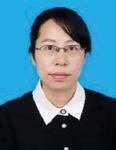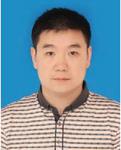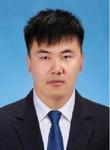Stability Modeling and Analysis of Grid Connected Doubly Fed Wind Energy Generation Based on Small Signal Model
Zheng Yangbing1, 2, Xue Xiao3, Wang Xing1, Cui Mingyue1 and Chao Lu4,*
1College of Mechanical and Electronic Engineering, Nanyang Normal University, Nanyang 473061, Henan, China
2Qinghai Wandong Ecological Environment Development Co.LTD, Geermu 816000, Qinghai, China
3School of Information Engineering, Nanyang Institute of Technology, Nanyang 473004, Henan, China
4Nanyang Zehui Technology Co.LTD, Nanyang 473000, Henan, China
E-mail: leo_phi856@163.com
*Corresponding Author
Received 18 July 2022; Accepted 09 August 2022; Publication 03 January 2023
Abstract
Stable wind power generation can ensure the quality of power transmitted by the grid. The application of large-scale grid-connected wind power systems will induce problems such as grid oscillation and frequency instability. In order to solve the problem of abnormal power system interaction caused by large-scale wind power access and improve the stability of grid-connected doubly-fed wind power generation, this paper proposes a stability modeling analysis of grid-connected doubly-fed wind power generation based on small signal model. First, the operating conditions of the grid-connected DFIG are analyzed, and the vector diagrams of the three operating conditions are given. When the grid-connected DFIG is in the super-synchronous working state, the sub-synchronous working state and the synchronous working state. According to the operating conditions of the grid-connected doubly-fed generators, the grid-connected doubly-fed wind power generation system is linearized. According to the relationship between the actual speed and the synchronous speed of the doubly-fed generator, the operating conditions of the doubly-fed generator are analyzed. By introducing the small-signal model, we analyze the small-signal of the grid-connected doubly-fed wind power generation system. The indirect current control circuit is used to perform reactive power compensation for grid-connected doubly-fed wind turbines. By calculating the reactive power loss of the grid-connected DFIG and the reactive power loss of the transmission line, the compensation capacity of the grid-connected DFIG is calculated. The transient voltage of the wind turbine is controlled by the rotor-side frequency converter, combined with the pitch angle control model. So far, this paper has realized the modeling analysis of grid-connected doubly-fed wind power generation stability. The simulation results show that the modeling analysis in this paper is reasonable for the small-signal analysis results of the stability of grid-connected doubly-fed wind power generation. In the rotor voltage simulation test, after the oscillation occurs for 1 s, the model starts to simulate and eliminate the fault. During the simulation period of 0.7 s1.0 s, the output voltage of the converter decreased to 168 V, and the voltage waveform did not fluctuate greatly after 1.0 s. The experimental results show that this method can improve the stability of grid-connected doubly-fed wind power generation.
Keywords: Small signal model, control strategy, stability modeling, doubly fed wind energy generation, operating conditions, compensation capacity.
1 Introduction
Nowadays, the scale of industrialization is gradually expanding, the scale of urbanization is gradually accelerating, and the process of urbanization is accelerating. At the same time, it also strengthens people’s standards for the environment [1]. At the same time of economic development, a large number of non-renewable energy sources have been exploited and used, making the energy consumption increase year by year [2]. In order to achieve the sustainable development of human living environment, various countries began to pay attention to environmental protection, and took the research on renewable energy as the development goal [3]. All regions have formulated relevant laws and regulations to promote the development of energy development strategy, protect the ecological environment and realize the sustainable development of mankind. From various aspects, a reasonably high-quality renewable energy source is wind energy., which has the advantages of no pollution and inexhaustible use, and widely exists in nature. Therefore, all countries in the world have begun to develop wind energy [4]. With the further improvement of the scientific and technological level, and the capacity of wind turbines is also becoming higher. The capacity is gradually upgraded from kW to MW, making wind energy generation more stable and significantly improving the economic and social benefits. However, with the popularization of wind energy generation, it needs to face more challenges and difficulties to be solved [5].
When standard methods are employed to control the transient stability of wind energy generation systems in domestic research. Zuo and colleagues examined the lift and drag coefficients of collectors with various angles of attack and various height angles using the computational fluid dynamics program STAR-CCM [6]. The force model of the disk solar collector is created by calculating the lift and drag coefficients of the concentrators at various wind attack angles and height angles. A lift-drag ratio-based stability criterion is established by choosing the bifurcation position. The main stability conditions of the disc solar collector are discovered by stability analysis. The feasibility of the suggested calculating approach is demonstrated through the analysis of the pitch torque coefficient. Lu Jia introduced a new control scheme considering the imbalance of active and reactive power [7]. By analyzing the speed change of wind turbine generator, energy imbalance of control system was accelerated and the oscillation of synchronous generator was reduced. The correctness of this method was verified by experiments. An example was given to verify that this method could speed up the recovery of the system to normal operation when the power generation system failed, so as to achieve the purpose of transient stability. In foreign studies, In order to ascertain the stability of the dish solar concentrator system. Tavoosi and colleagues proposed a fuzzy method for power stabilization control of grids including wind turbines and doubly-fed induction generators [8]. The method selects a recurrent type II fuzzy neural network control model of radial basis function networks for power control and voltage regulation of DFIG-equipped wind turbines. The voltage curve and grid reactive power of each bus are provided to the neural network control model as input and output for training. The simulation experiment shows that the method has good performance in controlling the fan and can improve the power quality to a certain extent. Devadason et al. [9] studied and improved the stability of a wind turbine squirrel-cage induction generator (WT-SCIG) with series compensation and weak interconnection to the grid. Stability domain analysis is performed by calculating the bifurcations in the system by analyzing the eigenvalues of the linearized system. They propose a damping controller that improves the dynamic stability of WT-SCIG with a wide range of series compensation to maximize power transfer capability.
At this stage, wind energy generation is the preferred renewable energy, which not only does not consume any resources, but also has no pollution. It is a green power generation technology to meet the current environmental protection and social development. In the 1960s, the cost of wind energy generation was higher than that of the same renewable energy, so the development of wind energy generation was limited. With the continuous development of the global economy, the utilization frequency of oil has gradually increased, resulting in the phenomenon of energy shortage in various countries. Therefore, wind energy generation technology has entered people’s vision again and has been paid attention to. Many countries have begun to build a large number of high-performance wind turbines. Up to now, large, medium and small wind turbines have gradually realized commercial value, and large-capacity units with a capacity of 6 MW have gradually been put into production. While wind energy has many advantages, it also has some disadvantages, such as the randomness and uncontrollability of wind energy due to the influence of environment and weather, so that the power supply capacity and power quality can not be effectively controlled, and the installation process is affected by the environment, resulting in great construction risks and difficulties. At the same time, wind energy generation is a large rotating mechanical equipment, which will also have a certain impact and change on the ecological environment during its operation.
The grid-connected double-fed fan has the advantages of simple structure and low operating cost. At present, wind power generation is developing rapidly, and it is of great significance to study the stability of grid-connected doubly-fed wind power generation. In the non-ideal grid state, the stability of grid-connected doubly-fed wind power generation and its function law are analyzed to maintain the stable operation of power generation. To this end, we use a small-signal model to analyze the stability of grid-connected doubly-fed wind power generation.
Figure 1 Vector diagram of super synchronous steady state operation.
2 Stability Modeling and Analysis of Grid-Connected Doubly-Fed Wind Turbine Energy Generation
2.1 Analysis of Operation Conditions of Grid Connected Doubly Fed Machine
Generally speaking, the generator uses the doubly fed machine to generate power. In the stable state, the doubly fed machine always operates in the generator state. There is a relationship between the actual speed and synchronous speed of doubly-fed generator, the operation state can be divided into super synchronous working state (), sub synchronous working state () and synchronous working state ().
Using sub-synchronous, super-synchronous, synchronous and other methods, the stator winding of the DFIG can directly provide power to the grid [10]. The doubly fed wind turbine’s rotor winding is driven by back-to-back converters when super synchronization is present, which is the difference. The doubly fed wind turbine’s rotor winding cannot produce energy under the synchronous situation without taking the winding resistance into account.
Under the condition of super-synchronization of DFIG, its vector curve is shown in Figure 1.
Double-fed fans can alter their reactive power more easily. The findings demonstrate that, in the hypersynchronous condition, the system’s vector distribution is divided into three groups. The systems supplying reactive power to the grid are the first group. The second group is the reactive power consumption from the grid. The third type is a system that does not exchange reactive power with the grid. Figure 2 depicts the state in which the doubly fed wind turbine is operating.
Figure 2 Vector diagram of subsynchronous steady state operation.
Figure 3 Vector diagram of synchronous operation state.
When the double-fed fan is in the synchronous state, the state is shown in Figure 3.
According to the above process, the operating conditions of the doubly-fed wind turbine under grid-connected conditions are analyzed, which provides good operating conditions for the small signal analysis of the grid connected doubly fed wind energy generation system.
2.2 A Grid-connected Doubly Fed Wind Energy Generation System with a Small Signal Analysis Model
The change is quite comparable to the state shift following linearization when the DFIG connected to the grid is less disrupted [11], with an eye toward the operational state of the grid-connected DFIG. The nonlinear treatment is as follows:
| (1) |
In formula (1), represents the state variable of the generator, and represents characteristic matrix of the generator.
According to the mathematical expression of small signal model, the stability of grid connected wind energy generation was judged by determining the characteristic range of wind turbine and observing the moving direction of characteristic value.
After the eigenvalue of the system is obtained, the corresponding eigenvalue is obtained by mathematical method. If the real value is greater than 0, the system is oscillating. If the real value is less than 0, it indicates that the grid connected doubly fed wind energy generation system is in a stable state. If the real part of the eigenvalue is 0, it means that the system is a critical point at this time [12].
From the characteristics represented by the complex number, it can be expressed by the following formula:
| (2) |
When the complex number has no imaginary part, the eigenvalue is 0.
According to the complex characteristic of the eigenvalue, the real part is the wind turbine’s response attenuation when linked to the grid, and the imaginary part is the grid-connected, doubly-fed wind turbine’s vibration state frequency. When is greater than 0, it shows that doubly fed is stable. if is less than 0, it indicates that the stability of the grid connected doubly fed wind energy generation is gradually strengthened [13, 14].
The power generation stability responds to each variable differently when the doubly fed wind energy generation system is subject to very minor disturbance. Assuming that represents the left eigenvector. and represents the right eigenvector. , and the following relationship is obtained:
| (3) |
According to the above analysis, the participation degree k is obtained by defining the ratio of -th state variable to -th characteristic value , and the formula is:
| (4) |
To explain the dynamic process of system functioning, the corresponding small signal model is built by choosing a group of relevant state variable parameters.
2.3 Calculation of Compensation Capacity of Grid Connected Doubly Fed Wind Turbine
Reactive power compensation must be carried out for doubly fed induction generator linked to the grid in the event that the wind power generation system fails. The grid-connected, doubly-fed fans must be compensated in order to fulfill the goal of reactive power compensation [15, 16]. The related control grid-connection technology, doubly fed induction generator is created using the notion of reactive power compensation. The grid-connected DFIG’s compensating capacity is determined arbitrarily. There are two methods for compensating: DC control and indirect current control.
In this study, the grid connected doubly fed wind energy generation’s intermediate current control circuit’s reactive power compensation is implemented using the indirect current control approach. In Figure 4, the control model is displayed.
Figure 4 The control circuit of indirect current.
Even if the grid-connected doubly-fed wind turbine is being employed, it is still possible to realize the reactive power adjustment. However, if there are any grid-related issues, the doubly-fed wind farms connected to grid wind energy can accurately make up for the reactive power. This guarantees the grid-connected, doubly-fed wind farm’s steady operation [17, 18].
The following formula represents the reactive power loss of grid-connected doubly-fed fans:
| (5) |
In the above formula, is the total reactive power loss of grid-connected wind turbines, represents the number of generator sets under parallel operation, is active power of the generator set, represents the reactive power, represents the rated voltage of wind turbine, represents the rated capacity, is the voltage at the time of the short-circuit fault of the wind turbine, and represents the current percentage of the wind turbine generator set in case of no-load operation.
The compensation content of the grid-connected doubly-fed wind turbine not only includes the loss of the unit itself. Also includes reactive power losses in transmission lines [19], which can be calculated by using the following formula, namely:
| (6) |
Where is the equivalent reactance of the transmission line.
2.4 Construction of the Stability Model for Grid Connected Doubly Fed Wind Energy Generation
We have constructed a mathematical model for the stability of the lower doubly-fed wind power system connected to the grid, And instantaneous control is implemented to guarantee the system’s steady functioning [20]. The transient voltage regulator is used to govern the doubly-fed grid-connected wind turbine’s functioning, which can maintain it steady when it uses the power grid. On the basis of this, doubly-fed wind turbine in grid-connected operation stability model is presented.
Figure 5 Stability model of grid connected doubly fed wind energy generation.
The doubly-fed wind turbine is the first to establish the standard, as seen in Figure 5. We optimized the doubly-fed wind turbine for grid-connected operation. Make sure it is functioning properly in the electrical system. When an accident occurs, the voltage of the grid-connected doubly-fed wind turbine will drop. The reactive power regulation of the grid-connected wind turbine is carried out under the assumption that the stability of the power grid will be ensured and that the torque of the power grid will be controlled within a specific range. It must be properly managed to reduce the operating pressure of the grid-connected doubly-fed grid [21, 22].
Controlling the pitch angle is the major factor in the mechanical torque of the grid-connected, doubly fed induction generator system being reduced. The pitch angle control model is shown in Figure 6.
Figure 6 Pitch angle control model.
It can be seen from Figure 6 that in the pitch angle control system, the speed reference value of the DFIG under grid-connected operation is set first. In case of system failure, the pitch angle starts to control. When the control system obtains the actual measured value, it will compensate the signal according to the reference value of the speed of the wind turbine, and compensate the mechanical torque of the wind turbine of grid connected doubly fed wind energy generation in combination with the small signal model.
3 Simulation Analysis
3.1 Simulation of Control Strategy for Grid Connected Doubly Fed Wind Energy Generation
In order to demonstrate the stability of the doubly-fed wind turbine, MATLAB simulation is used in this paper. Grid connected double fed wind energy generation’s stability can be guaranteed by managing the generation of that energy. In the control strategy simulation, a simulation model of grid-connected doubly-fed wind power generation control is established, as shown in Figure 7.
Figure 7 Simulation model of double-fed grid-connected wind power generation.
The configured control parameters for simulation mode are:
The voltage at the DC side of the grid connected converter in the doubly fed wind turbine is 250 V;
Through the voltage outer loop control, the proportional coefficient is set as 1, and the model integral coefficient is set as 200;
Under the condition of satisfying the unit power factor, the reactive power of the wind energy generation system is set as 0 var;
When the wind energy generation system is in operation, the rated power of the power grid is set to 25 Hz;
When the voltage current loop control is adopted, the current loop proportional coefficient in the grid connected doubly-fed wind energy generation system is 10 and integral coefficient is 1;
The filter inductance is set at the side of the power grid, and the inductance coefficient is 10 MH;
Figure 8 Three-phase current simulation waveform of the stator terminal of DFIG under different control methods.
The equivalent circuit is 0.1 .
After completing the setting of the above parameters, based on the simulation model in Figure 7, the linear control strategy of the converter is adopted. The reference [6] method and the reference [8] method are selected as the control group to analyze the output data of the grid-connected doubly-fed wind power generation control performance.
Under the ideal conditions of the power grid, the control simulation waveform of the doubly-fed wind turbine is obtained through the control strategies of different methods, as shown in Figure 8.
Under the ideal conditions of the power grid, the three-phase currents of the grid-connected control of the doubly-fed wind turbines controlled by the method of Reference [6] and Reference [8] are unbalanced to varying degrees. When the linear control strategy of the method in this paper is adopted, the three-phase current output by the grid-connected control of the DFIG is always in a balanced state, which meets the grid quality requirements of the grid for the DFIG. In Figure 8(b), the active power and reactive power output by the doubly-fed wind turbine under the method of this paper have been in a stable state, and both can be output independently. However, the power output by the method of Reference [6] and Reference [8] has unstable moments.
3.2 Simulation Analysis of Small Signal Stability of Grid Connected Doubly-Fed Wind Energy Generation System
3.2.1 Stability verification simulation of grid connected doubly fed wind energy generation system
The electrical parameters will exhibit short-time oscillation characteristics when the wind energy producing system is subject to an external disturbance. It is expected that the doubly fed generator set’s output active power rate is 2.0 pu and its speed is 2.4 pu.
The driving shaft of the generator is extremely likely to oscillate while the wind energy producing equipment is actually in use. The output voltage and power of the wind energy generation system will be out of balance as long as there is even a minor interference, which will prevent the power grid from operating steadily.
Figure 9 is a three-phase voltage waveform output from the stator terminal of the generator in the doubly-fed wind power generation system.
Figure 9 Simulation waveform of three-phase voltage at stator end.
At simulation periods ranging from 0.7 to 1.0 seconds in Figure 9, the voltage falls to 165 V. The doubly-fed wind turbine is simulated after 1 s, and the simulation outcomes demonstrate that the unit’s operational voltage has stabilized.
Figure 10 is the three-phase current waveform of the wind turbine stator terminal.
Figure 10 Simulation waveform of three-phase current at stator end.
In Figure 10, between 0.625 s and 0.65 s, the current at the stator end changes greatly, and within 0.71.0 seconds, the current reaches a stable state.
Figure 11 shows the simulation waveform of DC bus voltage of doubly fed wind turbine.
Figure 11 Simulation waveform of DC bus voltage of doubly fed wind turbine.
According to the results in Figure 11, after the system fault is recovered, the speed of the doubly fed wind turbine still oscillates to a certain extent, and there will be no obvious jump in energy, resulting in a rapid rise in the voltage of the DC bus. After a period of time, it returns to the normal state.
Figure 12 Rotor voltage of doubly fed wind energy generation system.
3.2.2 Simulation of grid connection parameters of doubly fed wind turbine module
The doubly fed induction generator will momentarily oscillate whenever a disturbance arises due to the influence of damping factors. As a result, the wind power plant’s electricity quality will be significantly impacted. seriously impair the electricity grid’s ability to function normally. Different representative elements are utilized in the simulation of grid-connected parameters of doubly-fed wind turbines to ascertain the impact of changes in power parameters on their stability. Figure 12 displays the rotor voltage simulation results for the doubly-fed wind power system.
According to Figure 12, the DFIG wind power generation system’s rotor voltage can essentially be kept at a low steady state for the duration of the simulation, which lasts between 0.6 and 1.0 seconds. The stator voltage of the DFIG wind turbine is steady for a while after the model is simulated and the problem is identified, but the rotor voltage swings significantly. This demonstrates that the doubly-fed grid-connected wind turbine’s capabilities for steady-state voltage control has some lag.
The voltage simulation of converter output in doubly fed wind energy generation system is shown in Figure 13.
Figure 13 Voltage simulation results of converter output.
It can be seen from the results in Figure 13 that during the simulation period of 0.7 s1.0 s, the output voltage of the converter decreases to 168 v, but the voltage waveform of the DFIG wind energy generation system converted by converter does not fluctuate significantly after 1.0 s, indicating that the grid connected doubly fed wind energy generation still has certain stability after the fault of the wind energy generation system is removed.
4 Conclusion
In this paper, a research on the stability modeling of grid-connected doubly-fed wind power generation based on the small-signal model is proposed. The model is used to analyze the stability performance of grid-connected doubly-fed wind power generation. It is reasonable to carry out modeling analysis. The three-phase current output by the grid-connected control of the doubly-fed wind turbine under the control of the method in this paper is always in a balanced state, while the output three-phase current under the control of the control method is unbalanced to varying degrees. It shows that the method in this paper ensures the stability of grid-connected doubly-fed wind power generation. Although the research in this paper can ensure the stability of wind power generation, there are still certain uncertainties in wind power generation.
Funding
This paper was funded by School level STP project in 2022: Research on key technologies of non-contact metal magnetic memory pipeline inspection (No. 2022STP010).
References
[1] Sohn A P, Maurício B. de C. Salles, Luís F. C. Alberto. Transient Stability of Power Systems Under High Penetrations of Wind Power Generation[J]. Journal of Control, Automation and Electrical Systems, 2019, 30(6):1116–1125.
[2] Santra S B, Ogungbe B T. A cogeneration scheme with biogas and improvement of frequency stability using inertia based control in AC microgrid[J]. International Journal of Emerging Electric Power Systems, 2021, 22(6):675–691.
[3] Rakhshani E, Gusain D, Sewdien V, et al. A Key Performance Indicator to Assess the Frequency Stability of Wind Generation Dominated Power System[J]. IEEE Access, 2019, PP(99):1–1.
[4] He L. DC Bus Voltage Adaptive Control for DC Microgrid with Wind Power Generator Systems[J]. International Core Journal of Engineering, 2019, 5(10):215–225.
[5] Du W, Ren B, Wang H, et al. Small-disturbance stability of a weakly grid-connected wind farm with multiple PMSGs dominated by the DC-link voltage dynamics[J]. IET Renewable Power Generation, 2020, 14(16):3103–3114.
[6] Zuo H, Liu G, Jiagiang E, et al. Catastrophic analysis on the stability of a large dish solar thermal power generation system with wind-induced vibration[J]. Solar Energy, 2019, 183(MAY):40–49.
[7] Lu Jia, Research on Intelligent Control of Transient Stability for Wind Power Generation System[J]. Journal of China Academy of Electronics and Information Technology, 2019, 14(3):321–326.
[8] Tavoosi J, Mohammadzadeh A, Pahlevanzadeh B, et al. A machine learning approach for active/reactive power control of grid-connected doubly-fed induction generators[J]. Ain Shams Engineering Journal, 2022, 13(2):101564.
[9] Devadason J, Moses P S, Masoum M. Stability Domain Analysis and Enhancement of Squirrel Cage Induction Generator Wind Turbines in Weak Grids[J]. Energies, 2021, 14(16):4786.
[10] Shah S, Koralewicz P, Gevorgian V, et al. Impedance Methods for Analyzing the Stability Impacts of Inverter-Based Resources: Stability Analysis Tools for Modern Power Systems[J]. IEEE Electrification Magazine, 2021, 9(1):53–65.
[11] Perzhabinsky S M, Karamov D N, Achitaev A A. A Model of Reliability Optimization of a Stand-Alone Electric Power System with Constraints on Dynamic Stability of the Wind Turbine[J]. Journal of Siberian Federal University Engineering & Technologies, 2021:55–71.
[12] Yuan Z, Wang W, Fan X. Back propagation neural network clustering architecture for stability enhancement and harmonic suppression in wind turbines for smart cities[J]. Computers & Electrical Engineering, 2019, 74:105–116.
[13] Ma R, Li X, Gao W, et al. Random-Fuzzy Chance-Constrained Programming Optimal Power Flow of Wind Integrated Power Considering Voltage Stability[J]. IEEE Access, 2020, 8:217957–217966.
[14] Naz M N, Imtiaz S, Bhatti M, et al. Dynamic Stability Improvement of Decentralized Wind Farms by Effective Distribution Static Compensator[J]. Journal of Modern Power Systems and Clean Energy, 2021, 9(3):516–525.
[15] Chen Y, Mazhari M, Chung C Y, et al. Rotor Angle Stability Prediction of Power Systems with High wind energy Penetration Using a Stability Index Vector[J]. IEEE Transactions on Power Systems, 2020, PP(99):1–1.
[16] Yi J, Lin W, Hu J, et al. An Integrated Model-driven and Data-driven Method for On-line Prediction of Transient Stability of Power System with wind energy Generation[J]. IEEE Access, 2020, PP(99):1–1.
[17] Wu A, Zhao B, Mao J, et al. Adaptive active fault-tolerant MPPT control for wind energy generation system under partial loss of actuator effectiveness[J]. International Journal of Electrical Power & Energy Systems, 2019, 105(FEB.):660–670.
[18] Dai B. Design of complex wind energy generation parameter control system based on embedded control combined with Internet of Things[J]. Web Intelligence and Agent Systems, 2019, 17(2):131–139.
[19] Rakhshani E, Gusain D, Sewdien V, et al. A Key Performance Indicator to Assess the Frequency Stability of Wind Generation Dominated Power System[J]. IEEE Access, 2019, PP(99):1–1.
[20] Said S, Aly M, Hartmann B. A robust-SMES control for enhancing stability of distribution systems fed from intermittent wind energy generation[J]. Turkish Journal of Electrical Engineering and Computer Sciences, 2019, 99(99):1–16.
[21] Zheng D, Ouyang J, Xiong X, et al. Rotor angle stability control for DFIG-integrated power system considering phase-amplitude characteristics of transient-grid voltage[J]. Generation, Transmission & Distribution, IET, 2019, 13(16):3549–3555.
[22] Jobayer A M, Chowdhury M R, Zhao L, et al. Impact of Societal Events on Frequency Stability Considering LED TVs in Low Inertia Trending Power Systems[J]. IEEE Transactions on Industry Applications, 2021, PP(99):1–1.
Biographies

Zheng Yangbing, Associate Professor of control science and engineering, with Nanyang Normal University, Nanyang, China. She received her Bachelor of Engineering Science in Electronic Information Engineering from Nanyang Institute of Technology, Henan, China, in 2006; and the Doctor Degree of Engineering in detection technology and automatic equipment from China University of Mining and Technology, Beijing, China, in 2013, respectively. Her current research interests include active robot control, and nonlinear control.

Xue Xiao, Associate Professor of School of Electronic and Electrical Engineering in Nanyang Institute of Technology, Nanyang, China. He received his Bachelor of Engineering Science in Electronic Information Engineering from Nanyang Institute of Technology, Henan, China, in 2003; the Doctor Degree of Engineering in detection technology and automatic equipment from China University of Geosciences, Wuhan, China, in 2015. His current research interests include Detection technology, and intelligent control.

Wang Xing, Professor of control science and engineering, with Nanyang Normal University, Nanyang, China. He mainly undertakes the teaching of professional courses such as introduction to Internet of things and computer control system, and his research direction is computer control. He received his Bachelor’s Degree in electrical technology from the school of Computer Science of Henan University and his Master’s Degree in computer application technology from Wuhan University of Technology.

Cui Mingyue, Associate Professor of control science and engineering, with Nanyang Normal University, Nanyang, China. He graduated from the automation School of Chongqing University with the Doctorate in Engineering. His current research interests include mobile robot navigation and control.

Chao Lu, Engineer of Nanyang Zehui Technology Co., LTD. He received his Bachelor of Engineering Science in electronic information engineering form Nanyang Institute of Technology, Henan, China, in 2015.
Distributed Generation & Alternative Energy Journal, Vol. 38_2, 413–434.
doi: 10.13052/dgaej2156-3306.3823
© 2023 River Publishers

























